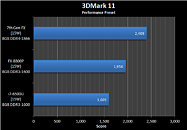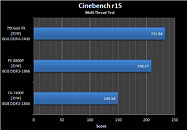Wednesday, April 6th 2016

AMD Outs "Bristol Ridge" APU Performance Numbers
Although AMD's upcoming socket AM4 heralds new lines of processors and APUs based on the company's next-generation "Zen" CPU micro-architecture, some of the first APUs will continue to be based the current "Excavator" architecture. The "Bristol Ridge" is one such chip. It made its mobile debut as the 7th generation A-Series and FX-Series mobile APUs, and is en route to the desktop platform, in the AM4 package. What sets the AM4 package apart from the FM2+ package, and in turn "Bristol Ridge" from "Carrizo" is that the platform integrates even the southbridge (FCH) into the APU die. This could explain the 1,331-pin count of the AM4 socket.
The "Bristol Ridge" silicon is likely built on the existing 28 nm process. That's not the only thing "current-gen" about this chip. Its CPU component consists of two "Excavator" modules that make up four CPU cores, with 4 MB total cache; and its integrated GPU will likely be based on the Graphics CoreNext 1.2 "Volcanic Islands" architecture, the same one which drives the "Tonga" and "Fiji" discrete GPUs. The integrated memory controller supports dual-channel DDR4 memory. In its performance benchmarks, an AM4 APU based on the "Bristol Ridge" silicon was pitted against older 6th generation APUs, in which it was found to be as much as 23 percent faster.
Source:
HardwareCanucks
The "Bristol Ridge" silicon is likely built on the existing 28 nm process. That's not the only thing "current-gen" about this chip. Its CPU component consists of two "Excavator" modules that make up four CPU cores, with 4 MB total cache; and its integrated GPU will likely be based on the Graphics CoreNext 1.2 "Volcanic Islands" architecture, the same one which drives the "Tonga" and "Fiji" discrete GPUs. The integrated memory controller supports dual-channel DDR4 memory. In its performance benchmarks, an AM4 APU based on the "Bristol Ridge" silicon was pitted against older 6th generation APUs, in which it was found to be as much as 23 percent faster.





68 Comments on AMD Outs "Bristol Ridge" APU Performance Numbers
As for the price, free-sync really doesn't need to add to the cost, since it's ya know free, just needs some firmware.
And while the cost might be on the small side, once they stick that Free-Sync sticker on the box, they love to jack up the cost to the consumer.
There's still currently no reason to buy an AMD based laptop, but the addition of free-sync and probably some purpose built ones with higher speed DDR4 is going to help out their performance a ton while maintaining a smaller form factor device.
They basically have to fill niche markets with their product to get anywhere with it, like you couldn't really fit a CPU + GPU into say a 10" netbook like device, but you could easily fit in the 15W APU with some high speed DDR4.
If we could get the better AMD processors in 35w chassis with fast dual channel ram and a price comparable to the 2-core i5 systems, then they'd have some appeal. Throttle them on battery, but let them run when plugged in.
Dedicated NV + i5 being cheaper than AMD APU makes no sense whatsoever.
And total perf being not so great, hey, have you checked TDPs?Jeez, but 940m alone is 30w, so you are at 45w.
Target of this is "ultra thins" and "2 in 1".
Just look at how well the PS4 performs given it's processor, a low power jaguar APU, yet it's pretty alright for gaming since it has GDDR5
Also, the maximum TDP isn't a big deal. The 940m(and 950m and 960m) turns completely off when there is no 3D load and the i5 has a 15w TDP, so when not gaming the TDP is the same as the AMD. So most of the time the laptop is in use, the Intel/nvidia combo will be the same. Actually, it will have better power consumption. Why? Because of the race to the halt state. Because the Intel processor performs better than the AMD, if it takes the Intel 1 second to complete a task, and the AMD 1.2 seconds, that means the AMD is running at full 15w TDP for 20% longer than the Intel to do the same tasks. Plus, Intel's low power states are more efficient than AMDs, so when the laptop is idle the Intel is using less power.
Yes, when gaming the Intel/nVidia combo will use more power, but that is a trade off most people who play games are likely willing to make. They'll trade the lower battery life for more gaming performance.
Old (super cheap) 360 with AMD APU was also available (was somewhat heavy and sucky screen though). Too lazy to dig a link. (I actually bought and returned it to amazon)
When I hear ultra-thin, I expect macbook air level of thin, not 1mm smaller than a normal laptop...